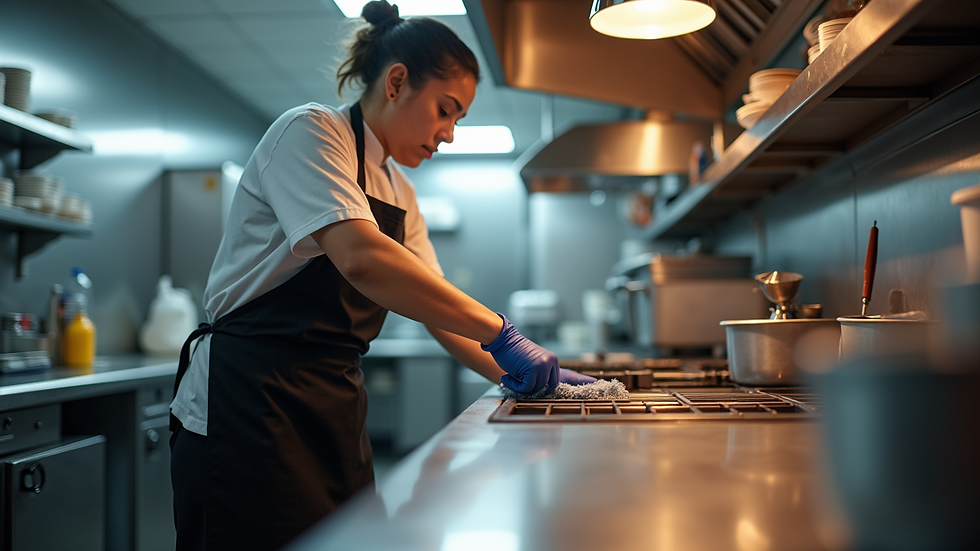Deep Cleaning Services for Pristine Restaurants
- contactsunsetclean
- Oct 13
- 3 min read
Maintaining a spotless restaurant is essential for attracting customers and ensuring their safety. Cleanliness reflects the quality of your establishment and directly impacts your reputation. While daily cleaning routines keep things tidy, deep cleaning is necessary to reach the hidden dirt and grime that accumulate over time. This blog post explores the importance of restaurant hygiene cleaning, practical tips, and how professional services can help maintain a pristine environment.
Why Restaurant Hygiene Cleaning is Crucial
Restaurant hygiene cleaning goes beyond surface-level tidying. It involves thorough sanitation of all areas, including kitchens, dining rooms, storage spaces, and ventilation systems. This level of cleaning is vital for several reasons:
Health and Safety Compliance: Restaurants must meet strict health codes to avoid fines and closures. Deep cleaning helps eliminate bacteria, mold, and pests that can cause foodborne illnesses.
Customer Confidence: A clean restaurant builds trust. Patrons are more likely to return and recommend your business if they see a spotless environment.
Longevity of Equipment: Grease and dirt buildup can damage kitchen appliances and surfaces. Regular deep cleaning extends the life of your equipment.
Improved Air Quality: Dust and grease in ventilation systems can affect air quality and pose fire hazards. Cleaning these systems ensures a safer atmosphere.
Implementing a regular schedule for restaurant hygiene cleaning ensures these benefits are consistently achieved.

Key Areas to Focus on During Restaurant Hygiene Cleaning
To achieve a truly pristine restaurant, focus on these critical areas during your deep cleaning sessions:
Kitchen Equipment and Surfaces
Grease and food particles accumulate on ovens, grills, fryers, and countertops. Use degreasers and scrubbing tools to remove stubborn residues. Don’t forget to clean underneath and behind appliances where dirt often hides.
Floors and Drains
Floors in kitchens and dining areas require scrubbing with appropriate cleaners to remove grease and spills. Drains should be unclogged and sanitized to prevent odors and bacterial growth.
Ventilation and Exhaust Systems
Grease buildup in vents and exhaust fans can cause fires and reduce air quality. Regular cleaning of these systems is essential for safety and efficiency.
Dining Area and Furniture
Tables, chairs, and booths should be wiped down and disinfected. Upholstery may need steam cleaning to remove stains and odors.
Storage Areas
Pantries and refrigerators must be cleaned to prevent contamination. Check for expired items and organize stock to maintain hygiene.

How much does a deep clean cost for a restaurant?
The cost of a deep clean for a restaurant varies depending on several factors:
Size of the Restaurant: Larger spaces require more time and resources.
Scope of Cleaning: Some restaurants may need only kitchen deep cleaning, while others require full facility cleaning.
Frequency: One-time deep cleans may cost more per visit than regular scheduled services.
Specialized Services: Cleaning ventilation systems or using eco-friendly products can affect pricing.
On average, deep cleaning services can range from a few hundred to several thousand dollars. It is best to request a detailed quote from professional cleaners who can assess your specific needs.
Investing in professional deep cleaning ensures thorough results and compliance with health standards.

Benefits of Hiring Professional Deep Cleaning Services
While in-house staff can handle daily cleaning, professional deep cleaning services offer several advantages:
Expertise and Experience: Professionals know the best techniques and products to use for different surfaces and equipment.
Time Efficiency: Deep cleaning is time-consuming. Outsourcing allows your team to focus on daily operations.
Advanced Equipment: Professional cleaners use industrial-grade tools that achieve better results.
Customized Cleaning Plans: Services can be tailored to your restaurant’s unique needs and schedule.
Compliance Assurance: Professionals stay updated on health regulations and ensure your restaurant meets all requirements.
Hiring experts for deep cleaning for restaurants is a smart investment that protects your business and customers.
Tips for Maintaining Cleanliness Between Deep Cleans
To keep your restaurant in top shape between professional deep cleans, follow these practical tips:
Daily Cleaning Checklists: Assign staff specific cleaning tasks to complete each day.
Regular Equipment Maintenance: Clean kitchen appliances after each use to prevent buildup.
Proper Waste Management: Dispose of garbage promptly and sanitize bins regularly.
Staff Training: Educate employees on hygiene best practices and the importance of cleanliness.
Spot Cleaning: Address spills and stains immediately to avoid permanent damage.
Scheduled Inspections: Conduct weekly walkthroughs to identify areas needing attention.
Consistent upkeep reduces the need for emergency deep cleans and keeps your restaurant welcoming.
Maintaining impeccable restaurant hygiene cleaning is essential for success. Combining daily efforts with professional deep cleaning services ensures a safe, healthy, and inviting environment for your customers. Prioritize cleanliness to protect your reputation and create a dining experience that keeps guests coming back.





Comments